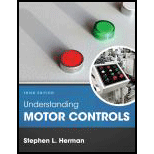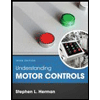
Understanding Motor Controls
3rd Edition
ISBN: 9781305498129
Author: Stephen L. Herman
Publisher: Cengage Learning
expand_more
expand_more
format_list_bulleted
Concept explainers
Question
Chapter 24, Problem 5RQ
To determine
From the given options, the factor that causes the given condition.
Expert Solution & Answer
Want to see the full answer?
Check out a sample textbook solution
Students have asked these similar questions
Correct Answer is written below(preferably handwritten solution) . Detailed and complete fbd only please. I will upvote, thank you.
The pressure and temperature at the beginning of compression of a cold air-standard Diesel cycle are 100 kPa and 300 K , respectively. At the end of the heat addition, the pressure is 7.2 MPa and the temperature is 2050 K . Assume constant specific heats evaluated at 300 K .
Determine:(a) the compression ratio.(b) the cutoff ratio.(c) the percent thermal efficiency of the cycle.(d) the mean effective pressure, in kPa
Correct Answer is written below(preferably handwritten solution) . Detailed and complete fbd only please. I will upvote, thank you.
Chapter 24 Solutions
Understanding Motor Controls
Knowledge Booster
Learn more about
Need a deep-dive on the concept behind this application? Look no further. Learn more about this topic, mechanical-engineering and related others by exploring similar questions and additional content below.Similar questions
- Correct Answer is written below(preferably handwritten solution) . Detailed and complete fbd only please. I will upvote, thank you. 7: The round bar AB in the figure is formed into a quartercircular arc of radius R that lies in the horizontal plane. The bar is built in atB and carries the vertical force P at end A. Given: P = 3 kN, R = 900 mm andα = 25°.1. Calculate the bending moment (kN-m) acting at section C.2. Calculate the torsional moment (kN-m) acting at section C.3. If the allowable torsional stress is limited to 65 MPa, calculate therequired minimum diameter of the bar (mm).ANSWERS: 1.14 kN-m; 0.25 kN-m; 60 mmarrow_forwardCorrect Answer is written below(preferably handwritten solution) . Detailed and complete fbd only please. I will upvote, thank you.arrow_forwardCurrent Attempt in Progress A cold air-standard Otto cycle has a compression ratio of 9 and the temperature and pressure at the beginning of the compression process are 520°R and 14.2 lbf/in.², respectively. The heat addition per unit mass of air is 600 Btu/lb. Assume constant specific heats evaluted at 520°R. Determine: (a) the maximum temperature, in °R. (b) the maximum pressure, in lbf/in.² (c) the percent thermal efficiency. (d) the mean effective pressure, in lbf/in.²arrow_forward
- Correct Answer is written below(preferably handwritten solution) . Detailed and complete fbd only please. I will upvote, thank you.arrow_forwardCorrect answer and complete detailed fbd only. I will upvote. : The two steel shafts, each with one end builtinto a rigid support, have flanges attached to their freeends. The flanges are to be bolted together. However,initially there is a 6⁰ mismatch in the location of the boltholes as shown in the figure. Determine the maximumshear stress(ksi) in each shaft after the flanges have beenbolted together. The shear modulus of elasticity for steelis 12 x 106 psi. Neglect deformations of the bolts and theflanges.arrow_forwardCorrect detailed answer and complete fbd only. I will upvote. The compound shaft, composed of steel,aluminum, and bronze segments, carries the two torquesshown in the figure. If TC = 250 lb-ft, determine the maximumshear stress developed in each material (in ksi). The moduliof rigidity for steel, aluminum, and bronze are 12 x 106 psi, 4x 106 psi, and 6 x 106 psi, respectivelyarrow_forward
- Correct answer and complete fbd only. I will upvote. A flanged bolt coupling consists of two concentric rows of bolts. The inner row has 6 nos. of 16mm diameterbolts spaced evenly in a circle of 250mm in diameter. The outer row of has 10 nos. of 25 mm diameter bolts spaced evenly in a circle of 500mm in diameter. If the allowable shear stress on one bolt is 60 MPa, determine the torque capacity of the coupling. The Poisson’s ratio of the inner row of bolts is 0.2 while that of the outer row is 0.25 and the bolts are steel, E =200 GPa.arrow_forwardCorrect answer and complete fbd only. I will upvote. The shaft carries a total torque T0 that is uniformly distributedover its length L. Determine the angle of twist (degrees) of the shaft in termsif T0 = 1.2 kN-m, L = 2 m, G = 80 GPa, and diameter = 120 mmarrow_forward7) find the Emax for figure below. 250N Ans: Tmay 7.5 MPa Gomm 350mm 50mm 4arrow_forward
- Water is supplied at 150 ft³/s and 70 psi to a hydraulic turbine through a 3-ft inside-diameter inlet pipe as indicated in the figure below. The turbine discharge pipe has a 4.8-ft inside diameter. The static pressure at section (2), 10 ft below the turbine inlet, is 10 in. Hg vacuum. If the turbine develops 2400 hp, determine the rate of loss of available energy between sections (1) and (2). Section (1) P₁ =70psi Q=150ft³/s D₁ = 3 ft 10 ft Turbine power loss = i P₂ = 10 in. Hg vacuum D₂ =4.8ft Section (2) de hparrow_forwardThis problem studies the response of two single degree of freedom bridge systems shown in Figure 1 under three loading cases. The problem has two parts. Part A and Part B use the same loading cases but the system is modified. Assume the following three loading cases in both Part A and Part B: (a) Harmonic wind load acting on the bridge deck pw(t) = powsin(ωwt) with amplitude pow and forcing circular frequency ωw. (b) Harmonic displacement base excitation acting at the base of the bridge pier ug(t) = ugosin(ωgt) with amplitude ugo and displacement circular frequency ωg. (c) Rectangular pulse load acting on the bridge deck with amplitude pop and pulse duration td. Part A The system includes part of a bridge deck and a bridge pier shown in Figure 1(a). For each loading case find the symbolic expression of the peak shear force in the bridge pier assuming the following: • The bridge deck is rigid and it has a mass m. • The bridge deck is rigidly connected with the bridge pier (i.e.,…arrow_forwardspecific speed P #2 Q.2. A Pelton wheel turbine of 1.9 m diameter works under a head of 50 m at 150 rpm. The buckets are exposed to water jet which delivers from a nozzle of 20 cm in diameter. Find the overall efficiency power produced by the wheel if the buckets deflects the jet through an angle of 163°. coefficient of velocity as 0.98 [50 Marks] ·licosply Y and no Take thearrow_forward
arrow_back_ios
SEE MORE QUESTIONS
arrow_forward_ios
Recommended textbooks for you
 Understanding Motor ControlsMechanical EngineeringISBN:9781337798686Author:Stephen L. HermanPublisher:Delmar Cengage Learning
Understanding Motor ControlsMechanical EngineeringISBN:9781337798686Author:Stephen L. HermanPublisher:Delmar Cengage Learning Electrical Transformers and Rotating MachinesMechanical EngineeringISBN:9781305494817Author:Stephen L. HermanPublisher:Cengage Learning
Electrical Transformers and Rotating MachinesMechanical EngineeringISBN:9781305494817Author:Stephen L. HermanPublisher:Cengage Learning Understanding Motor ControlsMechanical EngineeringISBN:9781305498129Author:Stephen L. HermanPublisher:Cengage Learning
Understanding Motor ControlsMechanical EngineeringISBN:9781305498129Author:Stephen L. HermanPublisher:Cengage Learning

Understanding Motor Controls
Mechanical Engineering
ISBN:9781337798686
Author:Stephen L. Herman
Publisher:Delmar Cengage Learning

Electrical Transformers and Rotating Machines
Mechanical Engineering
ISBN:9781305494817
Author:Stephen L. Herman
Publisher:Cengage Learning

Understanding Motor Controls
Mechanical Engineering
ISBN:9781305498129
Author:Stephen L. Herman
Publisher:Cengage Learning